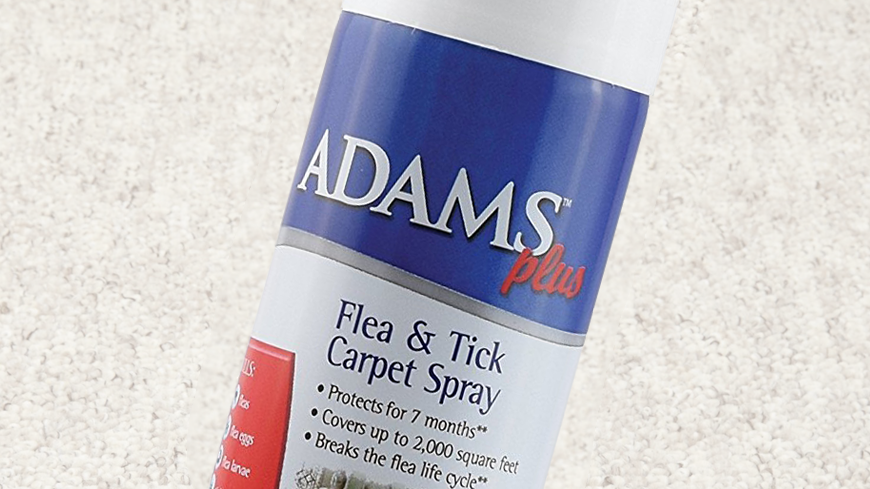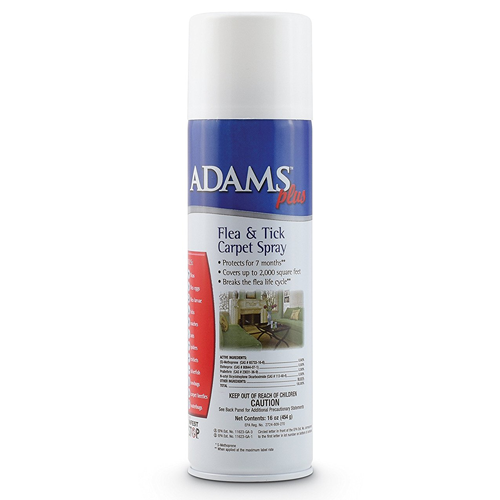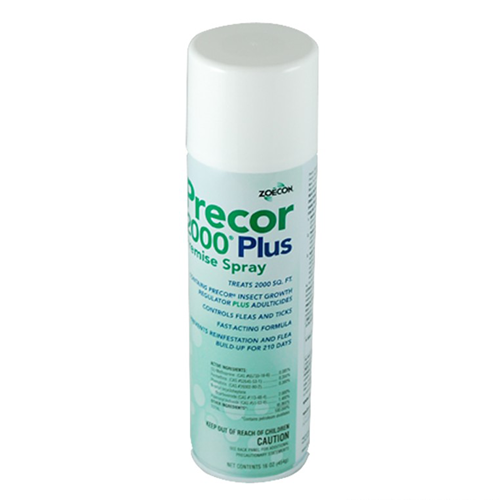Summary
Adams Plus Flea & Tick Carpet Spray is an aerosol insecticide. It’s mainly used to kill fleas and ticks, but can control other insect pests as well. Prallethrin and etofenprox are included in the spray to quickly kill adult fleas, while methoprene will prevent eggs and larvae from becoming adults for 7 months.
Adams Plus is a decent flea spray. However, it contains less insect growth regulator (methoprene) than other top competitors. This is the most important ingredient for premise sprays, because 95-99% of flea populations are pre-adults living in the environment. Thus, Precor 2000 Plus may be the better choice.
| Product name | Adams Plus Flea & Tick Carpet Spray |
| Active ingredients | 0.045% (s)-methoprene 0.500% etofenprox 0.300% prallethrin 0.500% MGK 264 98.655% other ingredients |
| Target pest | Fleas & ticks |
| Kills | Adults, eggs & larvae |
| Duration | 7 months |
| Size | 16 ounces |
| Capacity | 2000 sq ft |
| Application | Aerosol spray |
| Use on | Home premises |
| Manufacturer | Central Garden & Pet Company |
| UPC | 039079058834 |
| Product label | view |
| MSDS | view |
| Shop | Amazon.com |
| Price | $12 |
| Customer reviews | Read reviews |
| Competitors | Browse premise sprays |
- Prices are based on Amazon.com at time of publishing.
Details
How Adams Plus Flea & Tick Carpet Spray Works
Methoprene
Methoprene is an insect growth regulator (IGR). It works by mimicking juvenile hormone (JH) in insects. When JH or an IGR is present, young insects continue living as larvae. Normally, JH subsides and metamorphosis is triggered. However, those exposed to an IGR will never reach adulthood. In addition, IGR-exposed adult female can’t lay viable eggs. Methoprene lasts 7 months when applied indoors, which is great for control and prevention.
IGRs are the most important ingredient in flea premise sprays. This is because 95-99% of populations are eggs, larvae, and pupae living in the environment, often deep within carpets. Sprays can’t penetrate flea refuges well, which is why an insecticide with a long-lasting effect is important. Traditional insecticides aren’t as useful because they have a relatively brief period of activity. Plus, IGRs are considered safer, because they affect hormones rarely found outside of insects.
Etofenprox & Prallethrin
The adulticides in Adams Plus are etofenprox and prallethrin. Prallethrin is a pyrethroid, and etofenprox is a pyrethroid derivative. Pyrethroids are synthetic insecticides based on pyrethrum, a botanical compound found in Chrysanthemum flowers. Pyrethroids are typically altered to have superior chemical stability. They are commonly employed against fleas and other indoor pests. These insecticides work as neurotoxins, causing spasms, paralysis, and ultimately death.
When sprayed, Adams Plus should kill any emerged adults in the environment. Unfortunately, only 1-5% of fleas will be in the adult stage, and most of these will be living on pets. The adults don’t leave hosts of their own volition. Thus, few adults will be in the environment at any given time. This is why adulticides aren’t as important as IGRs.
Many immature stages won’t affected by the adulticides, because they live in protected refuges where sprays can penetrate well. Thus, many young fleas present at the time of spraying will eventually emerge as adults. However, they should be the last generation, since new eggs will fall onto IGR-treated surfaces and won’t survive.
MGK 264
N-octyl bicycloheptene dicarboximide (MGK 264) is a synergist. It doesn’t have insecticidal properties, but will boost the potency and efficacy of pyrethroids. This allows less insecticide to be used, resulting in safer and cheaper products.
Competitor Comparison
Adams Plus is a decent flea premise spray. However, top competitors contain more IGR, which is the most important active ingredient for environmental flea control. Of the professional aerosol sprays, Precor 2000 Plus is the cheapest choice by a small margin.
Instructions
The following instructions were taken from the Adams Plus product label. Before using the product, view the label for the full directions and precautionary statements.
DIRECTIONS FOR USE
It is a violation of Federal Law to use this product in a manner inconsistent with its labeling.
READ THE ENTIRE LABEL PRIOR TO USE. USE STRICTLY IN ACCORDANCE WITH ALL LABEL PRECAUTIONS AND DIRECTIONS.
GENERAL PRECAUTIONS AND RESTRICTIONS
- Do not allow adults, children, or pets to enter the treated area until sprays have dried.
- Do not wet articles to point of runoff or drip. Do not use treated article until spray has dried.
- Remove or cover exposed food and drinking water before application.
- Remove or cover dishes, utensils, food processing equipment, and food preparation surfaces, or wash them before use.
- To apply at the maximum rate, spray for 12 seconds to cover a 5 ft X 10 ft area. To apply at a lower rate and cover more area, spray for 12 seconds to cover a 10 X 10 ft area.
SHAKE WELL BEFORE USE
THIS PRODUCT IS NOT FOR USE ON HUMANS OR PETS.
Do not apply this product in a way that will contact adults, children, or pets either directly or through drift. Remove pets, birds, and cover fish aquariums before spraying.
Indoors:
Thoroughly vacuum all carpeting, upholstered furniture, along baseboards, under furniture, and in closets. Seal vacuum bag and dispose of in trash outdoors. For newly established or light flea/tick infestations, a single can treats 2000 square feet.
To apply at a lower rate and cover more area, spray for 12 seconds to cover a 10 X 10 ft area. To apply at the maximum rate, spray for 12 seconds to cover a 5 ft X 10 ft area.
Remove protective cap. Make a test application to upholstery or drapery fabrics in an inconspicuous place before use. Spray Adams™ Plus Flea & Tick Carpet Spray from 2 feet to 3 feet away from surface being treated. Apply with a smooth back-and-forth motion to carpets, drapes, rugs, and upholstered furniture. A fine mist spray that is evenly applied will do the job properly. Do not spray wood furniture, floors, or trim as water spotting may occur. Repeat treatment as necessary to control fleas and ticks.
Apply directly to exposed insects – roaches, ants, spiders, crickets, water bugs, silverfish, sowbugs, and carpet beetles: Spray areas where these pests are found or may hide, including dark corners of rooms and closets, cracks and crevices, along baseboards and door sills and frames, behind sinks, stoves, refrigerators, and cabinets, and around garbage cans, plumbing and other utility installations. Directly spray pests driven out of hiding places. Spray ant trails, nests, and points of entry. Repeat as necessary.
On Pet Bedding:
Treat pet bedding and resting places. Apply a uniform application of Adams™ Plus Flea & Tick Carpet Spray to nearby cracks and crevices, along and behind baseboards, window and door sills, and localized areas of floors where fleas or ticks may be present as these are primary hiding places for fleas. Pet bedding does not need to be removed after treatment.
Indoor Kennels:
REMOVE PETS BEFORE SPRAYING.
Spray Adams™ Plus Flea & Tick Carpet Spray from 2 feet to 3 feet away from surface being treated. Apply with a smooth back-and-forth motion. A fine mist spray that is evenly applied will do the job properly. Repeat treatment as necessary to control fleas and ticks. For best results, treat pets with a registered on-animal product before they return to the treated areas.
STORAGE AND DISPOSAL
Do not contaminate water, food, or feed by storage and disposal.
STORAGE: Do not store near heat or open flame. Store in cool, dry area away from children.
CONTAINER DISPOSAL: Do Not Puncture or Incinerate! If empty: Place in trash or offer for recycling if available. If partly filled: Call your local solid waste agency for disposal instructions.
Tips for Success
Target Hot-Spots
Fleas lay eggs on their host, but the eggs aren’t sticky and soon fall into the environment. Most eggs accumulate where pets spend time sleeping, grooming, and eating. In bedrooms, most tend to be found near beds. In living rooms, hot-spots occur near pet bedding or near seating.
When spraying, thoroughly treat the entire floor of infested rooms. However, special attention can be given to potential or identified hot-spots. If follow-up treatments are necessary, they can be limited to the hot-spots, where the majority of the final adults are emerging from.
Have Realistic Expectations
Realistic expectations lead to less stress. There isn’t any product or method that instantly ends a flea infestation. Control usually takes multiple months. This is because the bulk of infestations are immature stages living protected in the environment, where sprays and vacuums can’t penetrate. Many will survive control efforts. Before the infestation ends, all of these immature stages must mature, emerge, and die. New adult fleas emerging after spraying is common. It doesn’t mean that the spray failed. These new adults should be the last generation, as new eggs falling onto the IGR-treated surfaces won’t develop.
Pre-Emerged Adults
Pre-emerged adult fleas can cause many control issues. After pupating, adults can elect to stay within their cocoons and enter into a quiescent state. This sleep-like period can last for up to 5 months. However, heat and pressure (a host) will cause the fleas to immediately wake up and emerge. Vacuuming is one way to simulate these host cues and force emergence.
Vacuuming Procedure
Vacuum all carpets before spraying. This will lift up the carpet fibers, allowing the spray to penetrate deeper. Don’t vacuum again until the spray dries. Then vacuum around once every other day. Studies have demonstrated that dry vacuuming shouldn’t reduce insecticide efficacy. Vacuuming may actually improve efficacy by forcing cocooned adults to emerge into the insecticide.
Premise Sprays Aren’t Enough
Adult fleas account for 1-5% of infestations and live on their host. They won’t leave a host by choice. Premise treatments aren’t enough for flea control, because the on-host adults will continue to thrive. Each female will lay around 25 eggs a day. If any eggs fall onto an untreated surface, then the infestation will continue or restart.
Integrated flea control is the best way to fight fleas. Treat the environment to prevent immature stages from developing. Treat pets to kill adults before they can lay eggs. And a establish regular vacuuming routine to help eliminate fleas of all stages from the environment.







You must log in to post a comment. Log in now.